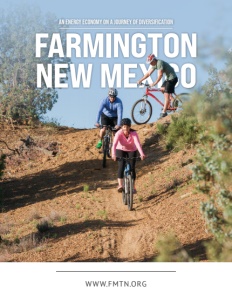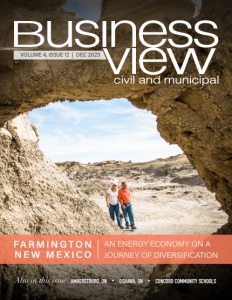Farmington, New Mexico
Farmington, NM: An Energy Economy on a Journey of Diversification
Discover Farmington, NM, where historic charm meets modern innovation, revealing a dynamic community thriving through collaborative growth, cultural richness, and forward-thinking initiatives.
Farmington, New Mexico, in San Juan County, presents a vibrant tapestry of cultural, economic, and geographical features. As one of the four metropolitan statistical areas in New Mexico, it boasts a population of 46,624, reflecting a microcosm of dynamic community life. Farmington’s strategic position in the northwest corner of New Mexico makes it a commercial nexus of the Four Corners region’s nearly 300,000 residents. As a result, the community remarkably expands to accommodate 150,000 shoppers during weekends.
The city’s allure extends beyond its commercial vibrancy. It offers diverse outdoor activities and a revitalized historic downtown area, making it an ideal destination for those seeking adventure and a slice of history. Geographically blessed, Farmington sits at the confluence of the San Juan, Animas, and La Plata rivers. This location historically fostered its development as a farming community and a distribution hub for the surrounding areas. Today, it serves as a gateway for exploring the Four Corners region’s picturesque landscapes and cultural treasures, with attractions like the Bisti Badlands beckoning explorers and enthusiasts alike.
He notes a significant shift in the mid-20th century with the discovery of oil and gas, marking a pivot from agriculture to energy. The San Juan Basin is a prolific natural gas basin, ensuring the city’s role in energy production for years to come. Alicia Corbell, Dean of the School of Energy at San Juan College, emphasizes New Mexico’s standing as the second-largest oil and gas producer in the United States. This fact underlines Farmington’s importance in the national energy landscape. It offers a glimpse into the significant role that the city plays in the broader economic and industrial fabric of the region and the state as a whole.
 Embracing Community and Culture in Farmington
Embracing Community and Culture in Farmington
Unsicker paints a vivid picture of Farmington’s commitment to community and quality of life. He notes, “The city of Farmington places immense value in the quality of place and life for our citizens. This is evident in the aesthetics and how our community engages with the city’s offerings.” The city’s park system, boasting over 58 parks, including water parks, skate parks, and a soon-to-be-constructed all-abilities park, offers a glimpse into this commitment. Reflecting on his experience, Unsicker adds, “When I moved here, it struck me that you couldn’t walk a quarter mile without encountering a park.”
Farmington demonstrates a solid commitment to recreational development, with Unsicker highlighting the city’s expansive river trail system along the Animas River, currently over nine miles, with plans for further extension. The construction of Bisti Bay Water Park and the upkeep of community pools and baseball fields emphasize the city’s dedication to active lifestyles and youth sports, including hosting the Connie Mack World Series.
Unsicker also mentions the $12 million investment in revitalizing Farmington’s downtown, featuring new roundabouts, wider sidewalks, and a district-wide outdoor sound system, significantly enhancing the city’s aesthetic. Infrastructure was also upgraded to future-proof buildings and attract new private investment. This revitalization beautifies the downtown area and acts as a driving force for further economic and cultural development, positioning Farmington as an exemplar of city rejuvenation.
Pioneering Infrastructure and Growth in Farmington
The city’s approach to growth, balancing the needs of today with the vision for tomorrow, is evident in its comprehensive planning and diverse development projects. While navigating unique geographical and economic challenges, this commitment to progress showcases Farmington’s ability to adapt and flourish in a rapidly evolving world.
Unsicker discusses the city’s forward-thinking approach to development. “We’re always looking toward the future,” he says. “Our 2040 comprehensive plan, completed a year and a half ago, guides our next steps. Although our economy has long been rooted in energy, we’re actively diversifying to mitigate the ebbs and flows of this sector.” This foresight is crucial as Farmington transitions from a predominantly energy-based economy to a more varied and resilient economic landscape.
He highlights significant infrastructure projects underscoring this transition. “We’ve invested in expanding our outdoor offerings and operate our own water, sewer, and electric utility, providing the lowest cost energy in the state,” Unsicker points out. He mentions that one of the major projects is the expansion of Pinon Hills Boulevard, a 40-plus-million-dollar endeavor designed to enhance connectivity and commuter access across the community. “This expansion serves our immediate population and the broader Four Corners area, catering to nearly 300,000 people,” he adds, indicating the scale of Farmington’s infrastructural ambitions.
Addressing the challenge of geographical constraints, Unsicker reveals a unique aspect of San Juan County. “Only 6% of the land here is privately held,” he notes. “The majority is under federal, state, or Native American control.” This situation creates a dichotomy for Farmington, presenting challenges and growth opportunities. Despite these limitations, the city continues to find innovative ways to expand and develop, a testament to its resilience and strategic planning.
Expanding Recreational Horizons in Farmington
Farmington’s spirit of innovation and community engagement extends beyond its streets and into the heart of its natural landscapes. The city’s dedication to enhancing its recreational offerings enriches its residents’ quality of life and beckons outdoor enthusiasts from far and wide. This blend of urban development and natural preservation underscores Farmington’s commitment to creating a balanced, vibrant community.
Unsicker expresses his enthusiasm for the city’s trail systems, particularly those along the river. “It’s a unique asset, especially in the high desert,” he says. “The trails teem with wildlife and greenery, offering a refreshing contrast to the arid surroundings.” He shares plans to expand this network to neighboring Aztec, potentially creating an interconnected trail system that would serve as a significant boon for both communities. “This expansion could transform how people commute and interact with our natural spaces,” he explains.
The city is bolstering its outdoor recreational offerings, notably with the Juniper Basin Bike Park, a 93-acre facility catering to cyclists of varying skill levels, complete with trails, drop jumps, and ramps. The city is also assessing 780 acres for further recreational developments. Unsicker highlights the Civic Center’s role in enriching the cultural scene, led by Randy West, with productions like ‘The Little Shop of Horrors’ and ‘Mamma Mia!’ bringing Broadway-caliber shows to Farmington. An outdoor amphitheater adds to the city’s cultural venues. Efforts to enhance walkability and cycling infrastructure are underway, with expanded bike trails and shared lanes, especially in the downtown area, aiming to foster a live-work-play environment through improved accessibility and housing options.

Economic Development and Collaborative Growth in Farmington
The economic landscape of Farmington is characterized by its robust private sector growth and collaborative efforts between various entities. This synergy among local businesses, educational institutions, and government bodies drives economic development and fosters a conducive environment for new ventures and innovations. The city’s strategic focus on incubating new businesses and diversifying its economic base is critical to its ongoing evolution and resilience.
Unsicker highlights several key local businesses contributing to Farmington’s economic growth. “Pesco, specializing in pressure vessels for the oil and gas industry, has expanded significantly, acquiring a second building and exploring new product lines,” he explains. He also mentions the expansion of Raytheon missile systems and the growth of San Juan Regional Medical Center and San Juan College, underscoring the breadth of Farmington’s economic base.
Unsicker highlighted some of the strategies aimed at diversifying Farmington’s economy through a concerted effort by all partners to achieve similar goals for the community. “Energy is shifting, and we intend to be at the forefront of the next wave of energy production in hydrogen, carbon sequestration, and other emerging technologies”. Corbell speaks about the unique opportunities they have been able to act on, being awarded federal funding to create curriculum around hydrogen career paths. Unsicker stressed that Farmington’s trained workforce is critical to attracting new businesses to the region.
Entrepreneurship is also a major priority for the region, with two business incubators, a Makers Space, and private co-working spaces. Ms. Corbell points to joint initiatives like Hawk Tank, a business plan competition, and an accelerator program as further resources for up-and-coming businesses. Additionally, Corbell underscores San Juan College’s economic significance, employing about 1100 people with an impact surpassing the Super Bowl. The college, known for its workforce training and industry partnerships, is recognized nationally, ranking 38th among U.S. community colleges and acclaimed as a Center of Excellence for Renewable Energy and Sustainability.
Strengthening Farmington Through Diverse Partnerships and Future-Oriented Initiatives
Farmington’s journey toward economic and cultural prosperity is paved with collaborative efforts, innovative thinking, and a solid commitment to community and workforce development. The city’s approach, focusing on diverse partnerships and forward-looking projects, enriches its present and secures its future as a dynamic, multifaceted community.
Unsicker emphasizes the city’s dedication to local commerce and regional collaboration. “We prioritize shopping locally and have built strong relationships with construction, engineering, and design firms,” he states. He highlights Farmington’s role as a regional economy: “Our partnerships extend to Durango, Colorado, Arizona, and the Navajo Nation, creating a synergistic economic environment.” The region plans to enhance its supply chain through rail infrastructure, supported by a $2 million federal grant to San Juan County, that will serve as a step towards increasing Farmington’s economic reach and logistic efficiency.
He emphasizes Farmington’s comprehensive approach to diversification, utilizing all the community’s strengths to create vibrant new industries. These include outdoor recreation manufacturing, agricultural processing, utilizing its unique landscape for the film industry, attracting location-neutral workers, and utilizing its long history & expertise in energy to grow into new sectors. Corbell highlights San Juan College’s exceptional ability to train and upskill workforce, both incumbent and emerging. According to a recent survey, 98% of students said they would recommend the college to their friends and family. Unsicker also discusses Farmington’s broader economic development strategy, focused on utilizing the city’s untapped assets that its founders helped to build and embracing new industries that will support its workforce and citizens.
Farmington, with its blend of historic respect and innovative ambition, continues to forge a path as a community that not only meets the needs of the present but also eagerly anticipates future opportunities.
AT A GLANCE
City of Farmington, New Mexico
What: A vibrant city evolving from agricultural roots to a hub of economic, cultural, and recreational development
Where: San Juan County, New Mexico, USA
Website: https://www.fmtn.org/



